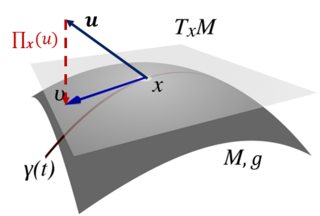„It’s just a jump to the left“
Everyone reading this should be familiar with the Taylor expansion of a function . It allows us to write
as a series of powers of
around some value
using only the local information in the neighborhood around
,
.
In particular, by Taylor’s theorem, the coefficients of the expansion are equivalent to and given by the successive derivatives of at
times an additional inverse factorial factor,
.
With that brief recapitulation out of the way, let us determine the Taylor series of the analytic function around
(yes, the power series expansion is also in
, not
). Since the argument of the function is linear, we find the derivatives to be given by
,
and therefore the power series by
.
In the last post, I wrote about a particularly interesting branch of mathematics called operational calculus, where you treat operators algebraically, i.e., separately from the function on which they act. Applying this approach to the sum on the right, separating the derivative from the function and then treating it as a number, yields
.
But what a minute! The sum in parentheses is just the formal power series of the exponential function, so
.
Looking back at where we came from, this implies the interesting result
thus, the scaled exponential of the derivative operator shifts the argument of the function on which it acts. In fact, this observation is quite old (Lagrange already knew it) and the operator is simply known as the shift operator*.
Before I continue with some examples, let us see if we can take this operator a little further. We start by substituting , from which simply follows
,
so nothing’s changed. On the other hand, we can apply the chain rule to the differential in the exponent and find
.
Now comes the interesting part. Since we could have chosen any analytic function , why not choose
(assuming
)? This way we have
,
and after some cleaning up of factors
This is a very important generalization of the simple shift operator and contains many interesting special cases for different values of , e.g.
Especially the second case, , is probably the second most important operator of this type. In fact, we can go even further. Why stop at
? Next we try the substitution
. Similar to before we find
,
which, by repeating the steps of applying the chain rule and replacing , yields
This is Sophus Lie’s renowned advective flow for Abelian groups (related to the iteration velocity of a function).
As an example of the use of the shift operator, consider the integral equation
,
where and which we want to solve for
. This integral is inspired by the Lamb-Bateman integral, while its solution is adapted from a paper by Babusci. In the first step, we use the shift operator to rewrite the equation as
.
By treating the derivative as a simple number, the integral can be calculated analytically as
,
which can be solved for in terms of
:
.
But how do we deal with a non-integer power of the derivative? This is exactly what the theory of fractional calculus was developed for. It’s a very rich framework but not widely known (same situation as with operational calculus) and I really recommend reading in+. We could just take the expression for the fractional derivative# from this theory. But instead, to connect these two aspects of mathematics, I want to use operational methods to heuristically derive a candidate for a fractional derivative. Take the fractional derivative for a non-integer order
. We „multiply by one“ to transform it into
. Since
, we now can use the identity
to rewrite the expression as
.
By shifting the variables in the integral, we obtain the Caputo representation of the fractional derivative#
.
With this integral we can now write down the solution for in terms of
:
.
Solving this integral equation was almost a trivial& task using the shift operator, whereas otherwise you wouldn’t even know where to start.
The general form of the shift operator is quite flexible and can therefore be applied to many similar integral equations like the one above. However, as I noted in the first post on operational calculus, this may be an easy way to find an answer, but it does not replace a rigorous proof that the solution is correct. For example, we don’t know if this is the only form of solution or under what conditions it exists. Also, functions that are not analytic are not well represented by this method. Nevertheless, the great advantage of using operational methods is that we now know what to expect and where to start, since we can work „backwards“ from the solution to understand why it works. In the next post, I want to dive even deeper into applications of the shift operator, especially in conjunction with something called the „time evolution operator“. But that’s it for now.
See you next time, Cheers!
If you’re interested in what’s possible with operators, take a look at the works of D. Babusci and G. Dattoli (I highly recommend it)
*This operator also appears in physics, especially in quantum mechanics, where it is known as translation operator
+Maybe I’ll do a post on this topic at some point
#There are other valid ways to define fractional differentiation, the most common being Riemann-Liouville integrals
&Probably not by most accounts, but I like that word

Hinterlasse einen Kommentar